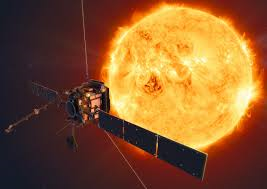A new spacecraft that will give us an unprecedented view of the Sun has blasted off into space.
Europe and Nasa’s Solar Orbiter was rocketed up to begin its journey to our star on Sunday night, with the aim of getting pictures of the kind never seen before.
“We’re on the way to the sun. Go Solar Orbiter!” said Cesar Garcia Marirrodriga, project manager for the European Space Agency. “It’s a fantastic moment … it’s like, well, we’re unstoppable.”
“Every instrument plays a different tune, but together they play the symphony of the sun,” Hasinger said.
Solar Orbiter was made in Europe, along with nine science instruments. NASA provided the 10th instrument and arranged the late-night launch from Cape Canaveral.
The rocket was visible for four full minutes after liftoff, a brilliant star piercing the night sky. Europe’s project scientist Daniel Mueller was thrilled, calling it “picture perfect.” His NASA counterpart, scientist Holly Gilbert, exclaimed, “One word: Wow.”
NASA declared success 1 1/2 hours later, once the Solar Orbiter’s solar wings were unfurled.
Solar Orbiter — a boxy 4,000-pound (1,800-kilogram) spacecraft with spindly instrument booms and antennas — will swing past Venus in December and again next year, and then past Earth, using the planets’ gravity to alter its path. Full science operations will begin in late 2021, with the first close solar encounter in 2022 and more every six months.
At its closest approach, Solar Orbiter will come within 26 million miles (42 million kilometers) of the sun, well within the orbit of Mercury.
Solar Orbiter’s head-on views should finally yield a full 3-D view of the sun, 93 million miles (150 million kilometers) from our home planet.
“With Solar Observatory looking right down at the poles, we’ll be able to see these huge coronal hole structures,” said Nicola Fox, director of NASA’s heliophysics division. “That’s where all the fast solar wind comes from … It really is a completely different view.”
To protect the sensitive instruments from the sun’s blistering heat, engineers devised a heat shield with an outer black coating made of burned bone charcoal similar to what was used in prehistoric cave paintings. The 10-foot-by-8-foot (3-meter-by-2.4-meter heat shield is just 15 inches (38 centimeters) thick, and made of titanium foil with gaps in between to shed heat. It can withstand temperatures up to nearly 1,000 degrees Fahrenheit (530 degrees Celsius).
Embedded in the heat shield are five peepholes of varying sizes that will stay open just long enough for the science instruments to take measurements in X-ray, ultraviolet, visible and other wavelengths.
The observations will shed light on other stars, providing clues as to the potential habitability of worlds in other solar systems.
Closer to home, the findings will help scientists better predict space weather, which can disrupt communications.
“We need to know how the sun affects the local environment here on Earth, and also Mars and the moon when we move there,” said Ian Walters, project manager for Airbus Defence and Space, which designed and built the spacecraft. “We’ve been lucky so far the last 150 years,” since a colossal solar storm last hit. “We need to predict that. We just can’t wait for it to happen.”
The U.S.-European Ulysses spacecraft, launched in 1990, flew over the sun’s poles, but from farther afield and with no cameras on board. It’s been silent for more than a decade.
Europe and NASA’s Soho spacecraft, launched in 1995, is still sending back valuable solar data.
Altogether, more than a dozen spacecraft have focused on the sun over the past 30 years. It took until now, however, for technology to allow elaborate spacecraft like Parker and Solar Orbiter to get close without being fried.
Fox considers it “a golden age” for solar physics.
“So much science still yet to do,” she said, “and definitely a great time to be a heliophysicist.”
The Independent
 Lebanese Ministry of Information
Lebanese Ministry of Information



